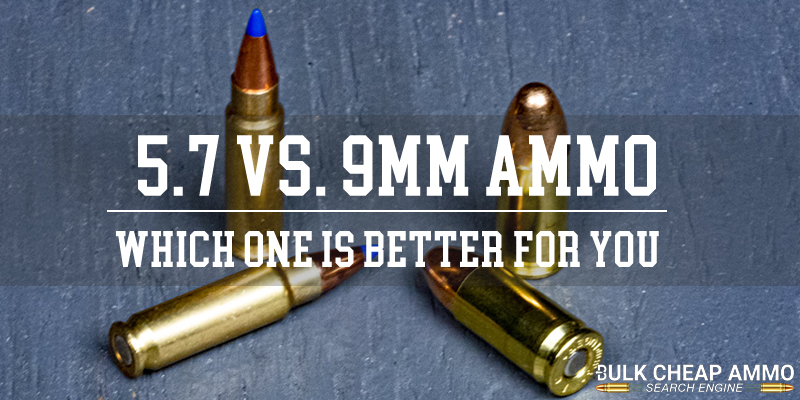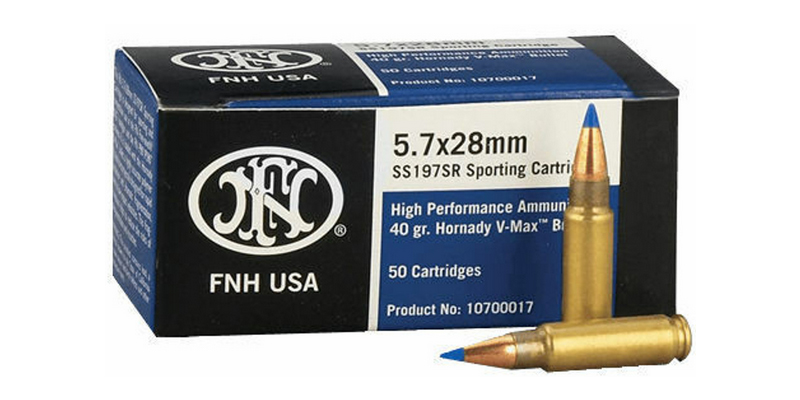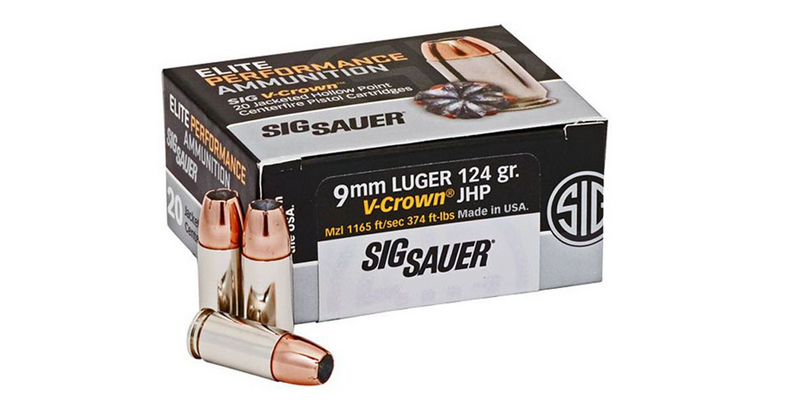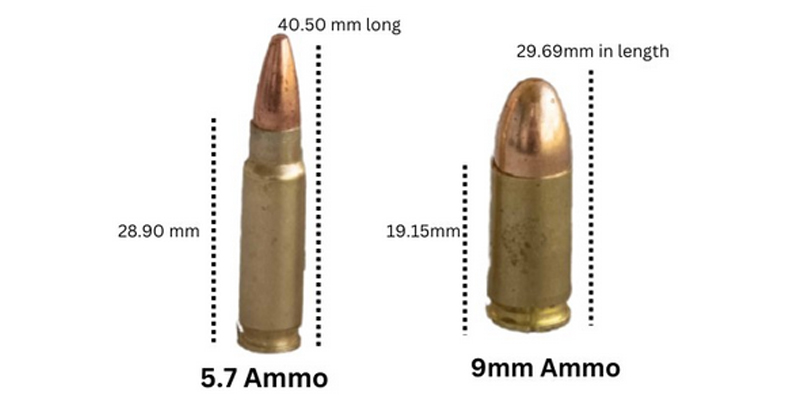Comparing 9mm caliber with 5.7 is also an interesting comparison debate for gun owners. As 9mm has been a proven performer for over 100 years for a reason, still 9mm may not have some cool factor that 5.7mm has.
That's why it is said that If any caliber has the potential to replace the 9mm, it would be the 5.7x28mm for sure.
But that's not possible for now because of 9mm advantages, availability & affordability.
As 9mm is most popular, but we can’t ignore the other calibers.
In our caliber comparison series, we have already compared the 9mm caliber with many other popular calibers like 10mm, 45 ACP, 9mm Makarov & many more.

Today, we are going to compare 5.7 vs. 9mm. When we compare 5.7x28mm Vs. 9mm, it's very easy to recognize both calibers by their shape & size.
But that's not enough.
Let's look in-depth at the 9mm Vs. 5.7 handgun cartridges to help you understand which is better for your needs.
| Specifications | 5.7 Ammo | 9mm |
| Designed by | FN Herstal | Georg Luger |
| Year of Design | 1989 | 1901 |
| Production | 1990-Present | 1902-Present |
| Parent Case | None | 7.65x21mm Parabellum |
| Case Type | Rebated Rim, Bottleneck | Rimless, Tapered |
| Bullet Diameter | 0.224 inches (5.70mm) | 0.355 inches (9.01mm) |
| Neck Diameter | 0.251 inches (6.38mm) | 0.380 inches (9.65mm) |
| Case Length | 1.138 inches (28.90mm) | 0.754 inches (19.15mm) |
| Case Capacity | 13.9 grain H20 | 13.30 grain H20 |
| Overall Length | 1.594 inches (40.50mm) | 1.169 inches (29.69mm) |

In the late 1980s, the development of the 5.7x28mm round was driven by FN Herstal, a Belgian firearms manufacturer.
The development vision was to fulfill the need for a compact and lightweight cartridge to enhance armor-piercing capabilities while maintaining controllability and minimizing recoil.
The 5.7x28mm achieved this by utilizing a small, bottlenecked case and lightweight bullets.
In 1990, the cartridge was officially introduced. Within a short period, these bullets gained attention for their unique characteristics. It featured a small-diameter, high-velocity bullet, typically weighing around 27 to 40 grains. The high velocity and the bullet’s design provided good penetration and effective terminal ballistics.

9mm ammo is among the most popular calibers globally from the last 100 years. For some reason, it is known as one of the most widely used handgun calibers worldwide.
With time, brands made various advancements and improvements in bullet design and performance to offer various ammunition options for different applications, including self-defense, target shooting, and competition shooting.
We have already discussed a brief 9mm overview in our previous post. Check these posts to learn details about 9 mm's history & development.

When we compare 9mm with 5.7 by bullet size & weight, there is a huge difference. The 5.7x28mm is the smaller cartridge in diameter, but it's longer than the 9x19mm Parabellum.
The 5.7 has a rebated rim bottleneck design, and the full cartridge is 40.50 mm long, with its case length covering 28.90 mm. Its bullet and neck diameters are 5.70 mm and 6.38 mm, respectively.
On the other hand, the 9mm case comes with a rimless and tapered design. These bullets have a 9.01mm diameter fitted in a neck of 9.65mm in diameter. The cartridge measures 29.69mm in length, with a case length of 19.15mm.
Most 9mm bullets are 115 grain, 124 grain & 147 grain compared to the 5.7mm bullets at 40 gr or 27 gr.
On average, the 5.7 weighs half of the 9mm Luger. This makes for larger magazine capacities and makes it easier to carry more rounds.
So, if you are looking for a small but powerful bullet, the 5.7 will be good to go.
Stopping power is determined by several factors, including penetration and velocity. The better a bullet penetrates, the more stopping power it is considered to have.
In comparing stopping power, between 5.7 and. 9mm, the 9mm bullet will penetrate better than the lighter 5.7mm bullet.
This means it should have more stopping power even though the 5.7 travels at 1,800 feet per second (fps).
The 9mm finally has a win for the average shooter, but for the military and law enforcement, the 5.7 stands out because of its armor-piercing abilities.
The backward force of the gun into your hands is known as “recoil. When we compare 5.7 Vs. 9mm by recoil, there is a slight difference.
The 5.7x28mm cartridge has less recoil than the 9mm Parabellum cartridge. This is because the 5.7mm bullet is lighter.
This makes the 5.7x28mm cartridge a good choice for shooters sensitive to recoil or new to shooting.
The reduced recoil of the 5.7x28mm cartridge also makes it easier to control the firearm, which can lead to improved accuracy.
The accuracy of a bullet always depends on many factors, but recoil is one of the most important factors that affect accuracy. Increased recoil can create unwanted movements that can affect the accuracy.
The accuracy of the 5.7x28mm and 9mm ammunition will be quite similar, but for the long distance, the 5.7x28mm holds an advantage over 9mm ammo due to its reduced recoil and flatter trajectory.
The muzzle velocity of a cartridge is the speed of the bullet when it leaves the barrel of the firearm. It is measured in feet per second (fps).
The 5.7x28mm cartridge has a higher muzzle velocity than the 9mm Parabellum cartridge.
This means the 5.7mm bullet travels faster when fired from a firearm.
The 5.7x28mm cartridge has a muzzle velocity of approximately 1,800 fps(depending on the specific loads), while the 9mm Parabellum cartridge has a muzzle velocity of roughly 1,100 fps.
The higher muzzle velocity of the 5.7 cartridge gives it several advantages over the 9mm cartridge, like Flatter trajectory, less recoil & greater energy.
The 5.7x28mm cartridge has a flatter trajectory than the 9mm Parabellum cartridge. This means the 5.7mm bullet will drop less over distance, making hitting targets at longer ranges easier.
For example, at a range of 100 yards, the 5.7mm bullet will drop approximately 3 inches, while the 9mm bullet will drop around 6 inches.
This difference in trajectory is due to the 5.7mm bullet's higher muzzle velocity and lighter weight. The higher muzzle velocity gives the shell more energy, which helps it to maintain its speed and trajectory over distance.
The 9mm bullet will generally penetrate better than the lighter 5.7mm bullet. This is because the 9mm bullet has more mass and momentum.
However, the 5.7x28mm SS190 cartridge is designed to penetrate body armor and can penetrate some types of body armor that 9mm cannot.
Here are some examples of penetration tests:
5.7mm ammunition is often chosen for specialized roles where armor-piercing capabilities and reduced recoil are critical, especially in military and law enforcement contexts.
On the other hand, 9mm is a versatile caliber widely used for self-defense, general-purpose firearms, and various shooting sports due to its well-balanced performance and ammunition options.
The choice between them should consider the specific application and individual preferences regarding firearm size, capacity, and recoil control.
The choice between 5.7mm and 9mm often extends to the selection of firearms, as different weapons are chambered for these calibers to serve various purposes. Here's a comparison of weapon selection for 5.7mm and 9mm ammunition:
5.7x28mm ammunition and firearms are less common than 9mm ammunition and firearms. This is because 5.7x28mm is a newer caliber and is less popular than 9mm.
5.7x28mm ammunition is generally more expensive than 9mm ammunition. This is because 5.7x28mm ammunition is produced in smaller quantities than 9mm.
For example, a box of 50 rounds of 5.7x28mm ammunition can cost around $22.50, while a box of 50 rounds of 9mm ammunition can cost approximately $11.99.
In conclusion, the debate between 5.7 vs. 9mm handguns is not a one-size-fits-all situation. Both calibers have advantages and disadvantages; the choice ultimately depends on your specific needs and preferences.
If you prioritize proven performance and widespread availability, the 9mm is a solid choice.
If you value low recoil, high capacity, and specialized capabilities like armor penetration, the 5.7mm may be more appealing.
© 2024 Bulk Cheap Ammo. All Rights Reserved.